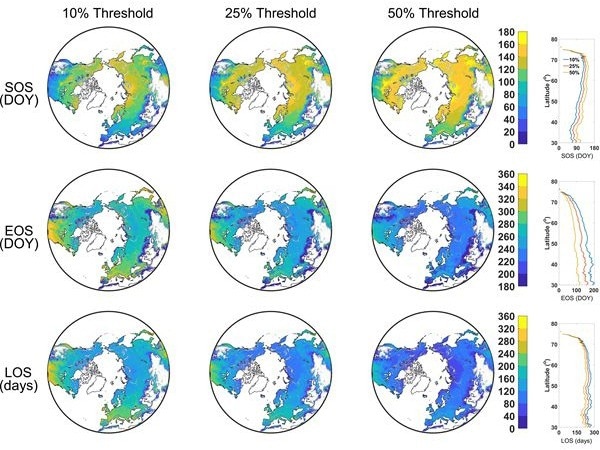Reviewed by Danielle Ellis, B.Sc.May 30 2023
The cycle sequence of important activities in vegetation is a particularly sensitive indicator of climatic changes in terrestrial ecosystems. Most recent studies have focused on structural changes in plants, such as employing greenness indicators to represent the growth process of leaves.
 The spatial distribution of the mean photosynthetic phenology metrics (first growing season) in the Northern Biomes of 2001–2020 (0.05° spatial resolution). DOY: day of the year. The right parts are the latitudinal pattern. Image Credit: Wuhan Botanical Garden
The spatial distribution of the mean photosynthetic phenology metrics (first growing season) in the Northern Biomes of 2001–2020 (0.05° spatial resolution). DOY: day of the year. The right parts are the latitudinal pattern. Image Credit: Wuhan Botanical Garden
These indices, however, are effective at identifying changes in chlorophyll concentration or structural alterations but are less sensitive to physiological changes in vegetation photosynthesis.
Investigators from the Chinese Academy of Sciences’ Wuhan Botanical Garden designed an approach integrating a smoothing filter and change-point detection to collect photosynthetic phenology from a recently designed satellite-based solar-induced chlorophyll fluorescence (SIF)-based gross primary productivity (GPP) product (GOSIF-GPP: 2001-2020) with a 0.05° spatial resolution.
Numerous phenological metrics were investigated, including photosynthesis state-transition dates (SOS), photosynthesis end-state-transition dates (EOS), and photosynthesis duration length for terrestrial ecosystems above 30° N latitude (northern biomes, including forests, savannas, shrublands, wetlands, grasslands, and croplands).

Image Credit: sivivolk/Shutterstock.com
The dataset comprises single-season and double-growing season phenology time, as well as the associated thresholds retrieved at 10%, 25%, and 50%. Each dataset is validated by comparing it to other vegetation indices or GPP data.
This phenology product captures numerous photosynthetic activities of vegetation and aids in the monitoring of the influence of climate change on terrestrial ecosystems.
Source:
Journal reference:
Fang, J., et al. (2023). Vegetation photosynthetic phenology dataset in northern terrestrial ecosystems. Scientific Data. doi.org/10.1038/s41597-023-02224-w.